Foot & Ankle Injury Treatment
Chipped Bone In Foot [Causes & Best Treatment]
Chipped Bone In Foot: Find out if you have a chipped bone in your foot? Or if it is something else entirely. The get rid of it!
Table of Contents
Chipped Bone In Foot Symptoms:
It is usually pretty obvious when it is a bone through your skin.
- It feels hard.
- You can feel it continue along the bone.
- It is usually immobile and stuck to the bone surface.
- It can cause skin pain against your shoe.
- It can cause nerve pain: numbness, burning & tingling.
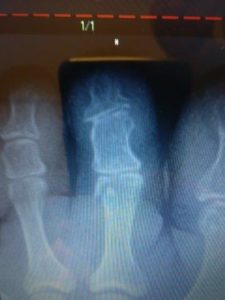
Causes Of A Chipped Bone In Foot:
Usually, it is not even a chipped bone that is causing your worry.
- It is a bone fragment known as an osteophyte.
- Osteophytes usually occur due to arthritis or trauma to a joint.
- It is known as exuberant (extra) bone formation in an area.
- If abnormal stress is placed on a joint, it can develop extra bone formation.
- This is most common in weight-bearing joints.
Chipped Bone In Foot Treatment:
The most common sites of this extra bone formation known as an osteophyte are:
1)The Big Toe Joint:
- This is usually about a condition known as hallux rigidus.
- So much extra bone can form that it decreases or even completely stops big toe joint motion.
- This leads to severe pain.
- It is known as degenerative joint disease.
- You can feel all the extra rough bone on top of your big toe joint!
2)The Top Of The Foot:
This is known as the 1st metatarsal cuneiform joint exostosis.
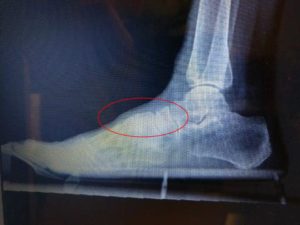
- This is a midfoot joint spur.
- This can compress the nerve the runs across the top of your foot.
- It can cause swelling & redness in the skin.
- It can cause numbness, burning, and tingling in the nerve.
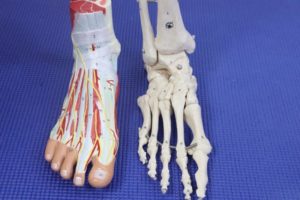
We find that the best way to relieve this pain is to skip the shoelace holes over this bone spur immediately.
3)The Ankle Joint:
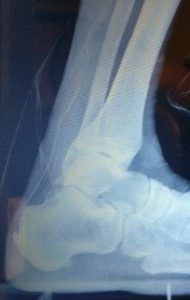
This is known as an anterior ankle spur.
- This can decrease the range of motion of your ankle dramatically.
- It can lead to ankle arthritis.
4)The Heel:
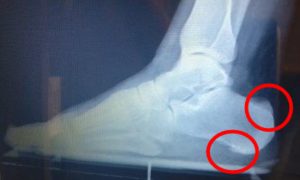
This is known as a heel spur.
- This is perhaps the most famous bone spur or osteophyte.
- This is actually an enthesophyte because the pull of a muscle causes it.
- This can happen at the bottom of the back of the heel.
- At the bottom, it is related to plantar fascia pain (plantar fasciitis).
- At the back, it is related to Achilles tendonitis & Achilles pain.
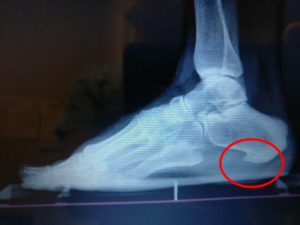
Achilles tendon-bone spur is at the back of the heel where the Achilles tendon inserts.
Minimally invasive bone spur surgery in the office:
Podiatrists and foot doctors can perform minimally invasive procedures in the office.
We can smooth bone chips and spurs in the office with a more reasonable recovery time and minimal incisions.
Come see our doctors to see if you may be a candidate for a minimally invasive procedure to remove a bone spur.
We can perform toenail, toe, foot, heel & ankle surgery in the office!
We can help with:
- Minimally invasive foot surgery.
- Minimally invasive bunion surgery.
- Minimally invasive hammertoe surgery.
- Corn and callus removal surgery.
- Plantar wart removal surgery.
- In-office permanent ingrown toenail removal surgery.
- Removal of unwanted spurs, bumps, or lumps on your feet.
- Shockwave therapy (AKA ESWT therapy or EPAT therapy)
- Cold laser therapy.
- MLS laser therapy (Multi-Wave Locked System laser therapy).
- Laser for peripheral neuropathy.
- 3D custom orthotic scan.
List of procedures our podiatrists can perform:
- Toenail Fungus Treatment (Oral or Laser ).
- Toenail Trimming.
- Orthotics Fitting.
- Ingrown Toenails.
- Infected Ingrown Toenails.
- Podiatrist pedicure or medical pedicure.
- Trimming of Corns, Trimming of Calluses, and Treatment of Pressure Blisters.
- Diabetic Foot Care & Diabetic Foot Wounds.
- Athletes Foot, Dry Skin, Eczema.
- Foot & Ankle Ulcer Care.
- Infection and Abscess Care.
- Staph Infections in the Toe or Foot Treatment.
- Treatment of Plantar Warts for Your Toes and Feet.
- Foot & Ankle Injections (Steroid or Natural Solutions.)
- Management of Foot & Ankle Fractures (Walking Boots for broken toes or broken feet).
- Heel Pain (Heel Spur or Plantar Fasciitis).
- Custom Orthotics for children and adults (In the office).
- Over the Counter Orthotics for children and adults.
- Podiatrist medical pedicure.
- Extra-Depth Shoes for Patients with Diabetes.
- Diabetic Shoes.
- Gout Treatment.
- Prescription (Refills).
- Telehealth appointments.
- Shockwave therapy (AKA ESWT or EPAT therapy)
- Cold laser therapy (In the office).
- MLS laser therapy (Multi-Wave Locked System laser therapy).
- Laser for peripheral neuropathy (In-Office).
- Senior Toenail Cutting & Toenail Trimming Services.